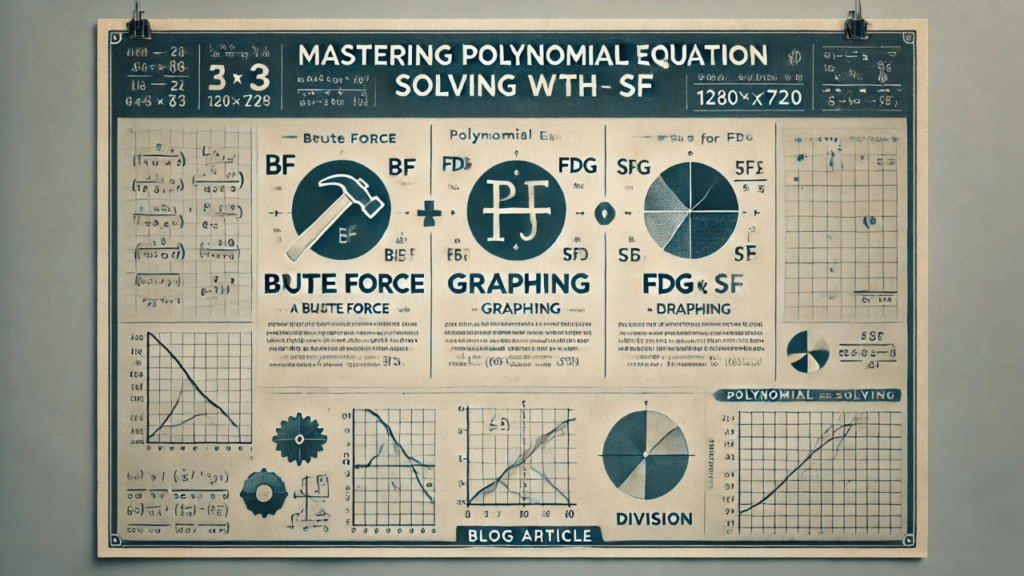Polynomial equations form the cornerstone of algebraic studies, presenting both challenges and opportunities for deep mathematical exploration. This article aims to demystify the complexities of Polynomial Equation Solving with BF FDG and SF, providing a comprehensive guide to mastering these methods. Whether you are a student, educator, or professional, understanding these strategies can significantly enhance your problem-solving capabilities.
Introduction to Polynomial Equation Solving with BF FDG and SF
Polynomial Equation Solving with BF FDG and SF encompasses a trio of techniques each suited to different types of polynomial equations. Each method offers unique advantages and is applicable in various scenarios that require algebraic solutions. By the end of this discussion, you will have a clearer understanding of how to apply these methods effectively.
Brute Force (BF) Approach
The Brute Force method in Polynomial Equation Solving with BF FDG and SF is straightforward: it involves substituting potential solutions into the polynomial equation until the correct answer is found. This method, while simple, can be time-consuming and inefficient for complex equations. However, it is an excellent way to begin exploring the nature of polynomial equations, especially for beginners learning the ropes of algebra.
Factorization, Division, and Graphing (FDG)
Moving to a more sophisticated level, the FDG method stands for Factorization, Division, and Graphing. Here’s how each component plays a crucial role in Polynomial Equation Solving with BF FDG and SF:
- Factorization: This involves breaking down a complex polynomial into simpler, easier-to-solve factors.
- Division: Techniques like synthetic division and polynomial long division simplify polynomials by dividing them into smaller, manageable parts.
- Graphing: Visualizing polynomials on a graph can help identify roots and understand the behavior of the equation across different values.
FDG is particularly useful for higher-degree polynomials and when a detailed analysis of polynomial behavior is necessary.
Synthetic Division and Factoring (SF)
Synthetic Division and Factoring (SF) are streamlined approaches that enhance the efficiency of solving polynomials. Synthetic division is a quicker alternative to long division, especially useful when the divisor is a simple binomial. Factoring, on the other hand, transforms the polynomial into a product of lower-degree polynomials, making it easier to find the roots.
Practical Applications and Examples
The practical application of Polynomial Equation Solving with BF FDG and SF is vast. In engineering, these techniques are used to design systems and solve optimization problems. In economics, they help model complex relationships and predict trends. For students, mastering these techniques can lead to improved academic performance and a better understanding of mathematical concepts.
Efficiency and Accuracy in Polynomial Equation Solving
The importance of choosing the right method for Polynomial Equation Solving with BF FDG and SF cannot be overstated. Each method offers a balance of efficiency and accuracy, suited for different types of polynomial equations. For instance, the Brute Force method, while straightforward, may not be the most efficient for higher-degree polynomials where the Factorization, Division, and Graphing (FDG) and Synthetic Division and Factoring (SF) methods could provide quicker and more accurate results.
Educational Impact of Mastering These Methods
In educational environments, teaching the nuances of Polynomial Equation Solving with BF FDG and SF can profoundly impact students’ problem-solving skills. These methods are not just about finding the right answers; they are about understanding the underlying mathematical principles. For educators, introducing these methods through interactive problem-solving sessions can help students appreciate the beauty of algebra.
Real-World Applications of BF, FDG, and SF
In real-world scenarios, the applications of Polynomial Equation Solving with BF FDG and SF are vast:
- Engineering: From designing bridges to optimizing electrical circuits, these methods help solve real-world engineering problems where precision is critical.
- Computer Science: Algorithms based on these solving techniques can be implemented in software applications to handle complex calculations and data analysis.
- Finance: In financial markets, polynomial models can predict stock movements and optimize investment strategies.
Challenges and Considerations
While the methods for Polynomial Equation Solving with BF FDG and SF are powerful, they come with their own set of challenges. Understanding the limitations and potential pitfalls of each method is crucial. For example, the Factorization method requires that the polynomial be factorable, which is not always the case. Similarly, Synthetic Division is only applicable for divisors of the first degree.
FAQs on Polynomial Equation Solving with BF FDG and SF
- What makes FDG preferable over BF in polynomial equation solving?
- FDG is more efficient for complex polynomials as it breaks down the equation into simpler parts, making it easier to solve, unlike BF, which can be more time-consuming and less directed.
- Can synthetic division be used for all types of polynomials in SF?
- Synthetic division is typically used when the divisor is a linear polynomial. For higher-degree divisors, other methods like polynomial long division might be more appropriate.
- How does graphing help in the FDG method?
- Graphing provides a visual representation of where the polynomial equation crosses the x-axis, which corresponds to the roots of the equation, offering a clear visual insight into the solutions.
- What are the limitations of using the Brute Force method in Polynomial Equation Solving with BF FDG and SF?
- The main limitation of the Brute Force method is its inefficiency, as it requires testing multiple values which can be impractical for equations with complex or irrational roots.
- How do professionals choose which method to use in real-world scenarios?
- The choice of method often depends on the specific requirements of the problem, the complexity of the polynomial, and the need for accuracy and efficiency in finding solutions.
YOU MAY READ ALSO: Eyes on the Future: How the Susan Greenberg Foundation is Reshaping Vision Science

